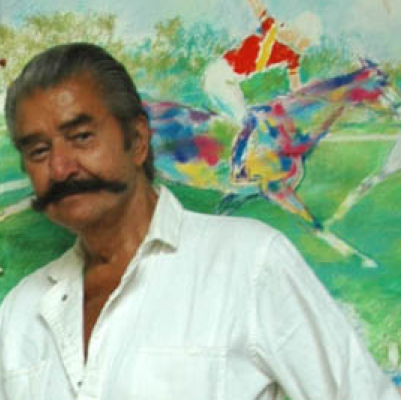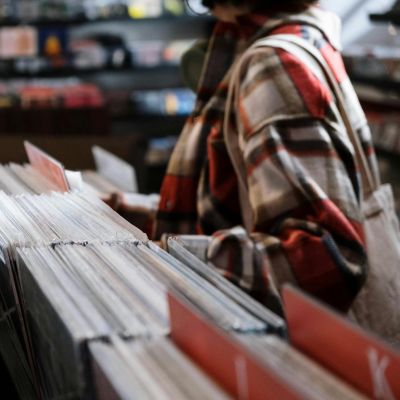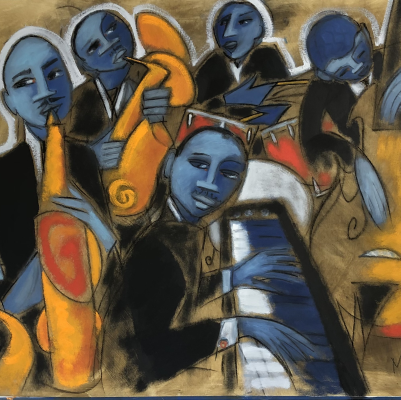The Train to Work
Smelling like French Whores,
The pin stripe pin heads
Read the Journal
Or discuss restaurants
And home improvement
While blue collars
Talk about wrestling
And politics
As if they were real.
The train to work
Brings me down…
Down to the city
It brings me down.
On the Cab Line
Shoes was wearin’ a poker face
Dead in his tracks at the Deauville.
First out on a line that ain’t moved
In an hour,
His head could be seen through the glass,
Restin’ in peace
Against the red upholstery,
The TV Guide in his lap
Open to an ad
Sellin’ bouquets of flowers.
Just then,
As a ball of spit
Collecting in the corner of his mouth
Begins a stringy descent to his shirt,
The doorman clangs his bell
And all hell breaks loose.
Behind him, Hooly honks his horn,
And swears into a corned beef sandwich,
Each wave of the doorman’s hand
Stoking flames of indigestion
To a roaring belch.
Old Gus, he shakes his one tan arm,
Spittin’ out words
With his head rattlin’
Like a Tommy gun,
“Hey wake up up there!…
“Wake up…Ya god damned bastid…”
But Shoes was wearin’ a poker face
Dead in his tracks at the Deauville.
All up and down the line
Hoods are rumblin’ and tires inchin’
Like dragsters at the light.
Then Short Change
Nudges Little Red
Who pokes his crimson face
Out the window
Wavin’ a racing form
Talkin’ neck injuries and lawyers,
In a car toon balloon
Of stale tobacco and booze.
And the Change, bangin’ on his door,
“Step over here,” he says,
An’ I’ll give ya neck injuries,”
With Cool Breeze tryin’ ta break it up
And doormen beatin’ on the bells,
So it sounds like a carny,
Jumpin’ up and down
Wavin’ their arms
Just like drownin’ men…
But Shoes was wearin’ a poker face
Dead in his tracks at the Deauville.
Finally, in one great roar
Of flatulent frustration
Hooly slams down his sandwich,
And, amidst the shrapnel
Of meat and mustard,
Kicks into drive
And squeals around Shoes,
Cursing him with a raised fist,
Forcing a motorist
To swerve out the way.
And then…
A chain reaction of cabs,
Drivers all salivating
To the sound of the bells,
Starts flowin’ like water
Round a log jam…
So when the cops arrived
They hadda laugh.
And while the leather
Of their gun belts sigh
And handcuffs
Tinkle like wind chimes,
They speak his eulogy
To the static
Of the radio waves,
“Hey Chally
“Call the meat wagon…”
Cause Shoes was wearin’ a poker face
Dead in his tracks at the Deauville.
Sinful Spring
Pink lemonade dogwoods puffed with pride
Flaming yellow forsythias going green with envy
Grass greening greedily
Angry April’s breezy blow
Lascivious loons croak conjugal cacophony
While gluttonous bees
Pollinate lustful lilies.
Windy Autumn Day
The old trees shake their great heads,
And point their gnarled limbs,
Nattering in crisp chorus,
As newly freed leaves
Race up driveways
Across lawns and roads
Like children
Gleefully fleeing mischief.
A Yard to Go
This is my yard.
I can plant my chair
Anywhere
I desire.
I desire now
The exquisite light
Of sunset
Filtered.
Tree limbs,
Shadows,
Long and
Lean
Hidden sounds of
Birds
Bugs
Distant dogs,
A salsa bass line
Walks
From the forest fringe.
Blue hills,
White, windowless
Sides of houses
Studies in parallel lines.
While each blade of grass
Throws its shadow
With the force
Of a major league pitcher.
I stare down a dog
Alternately wagging, barking.
Barking, wagging.
If I turn my chair
A scant degree,
Yet one more universe.
The Red Head
Autumn child
Rusty
Red
Brown
Eyes green,
Clear,
Sparkling
Streams
Scraping
Stone,
Leaves.
Let me be your Fall Guy.
At the Mission
Yeah…
It was just another day at the mission.
The bums, smelling like the seats of their pants
Were stacked like a roll of wooden nickels
Under a sky with mixed feelings.
Duecy was tryin to sell Detour last week’s Time
Sayin it was a girly mag,
When the sound of a distant siren
Made all heads
Rise
And
Fall
Like somebody dropped the name Jeeeesus in a convent.
Old dirty headed Charley moved his whiskered jaws
To grind long forgotten teeth,
Sputterin out tobacco,
Eyes winkin on and off
Like lights at a train crossin
Warnin of oncomin words,
“Down the Baptis’ mission ya gotta pray ta eat.”
He rubbed on his sooty head and winked even harder,
“De Catlicks, dey jus’ feed yas.”
Just then,
Welfare Mike,
Thumblock on the business end of a
Canadian Ace ‘Jug o Beer’
Hit the line roarin out a sea chanty.
He was nine sheets
With elbows sharp as broken glass
When he exploded into a hornpipe
Scatterin the boys like fish on a deck.
Some went down like bowlin pins
And some like broken birds,
Their curses,
Rusty as death rattles,
Rising on small puffs of bad breath.
Some shook themselves up with anger.
Others stayed down,
And shook like the insides of broken clocks.
Mike,
He kept movin,
The impersonation of a drunk.
Eyes rolling
Mouth writhing,
He wrestled out words in Portuguese,
Every now and then
Holdin up his hands
For close attention
To a line that held great meaning.
All the boys were singin and cheerin along
By the time Fat Father Freddie
Popped like a pimple
From the doors of St. Louis,
His head, a road map of blood vessels
Bursting above his cassock.
All eyes turned churchward,
And to the sign,
“No man will be served who has been drinking liquor.”
A man of black cloth
And red skin,
Lou Costello in a skirt,
Father Fred descended on Mike
Fists flailing
Flutter punches
And Stinky (“I’ll HARM YOU!”) kicks,
Till Mike hit the gutter
Singing a different tune.
From the heights of the church
The stone faces of the saint’s crusade
Looked on with the gargoyles.
Duecy and Detour
(Previously published: Confluence, May 1992)
The ultimate white man
Took his ax to St. Peter
And blew…blue…blew.
Below
Piss colored hair
Albino pink eyes,
Blind
To the fluttering white moths
Of his eyelids,
See only
The rain of notes
Reigning
The clarinet’s shaft
So black
So black
On his ghost’s skin.
Into the night,
Notes…
Notes in tiny spats
And top hats
Dance
In a land of rooftops
And neon soaked streets.
Into the night,
Settling softshoe
On a bus named Desire,
They leap warehouse and factory
And junkyard,
Where skeleton dogs
Howl ancient songs
From metal foothills,
In tune with the whirling wail
Cartoon scale.
Into the night,
They hover a river
Stripped to starshine
And running lights,
Kissing with wet tongues,
The shores
Of broken glass
And twisted metal bands.
Into the night
This sky swirling,
Horde of hip locusts
Dives
Deep, deep, and deep
Into the heart of a freight car
Parked at some riverfront switching yard,
Where tracks sew moonbeams
Into white pin stripes.
Deep, deep
Into the corner
Where Joe Detour and the Duece
Divide dreams
And the sticky red heaven
Of a fifty cent bottle.
“You hear somethin’?”
“Nah..”

































